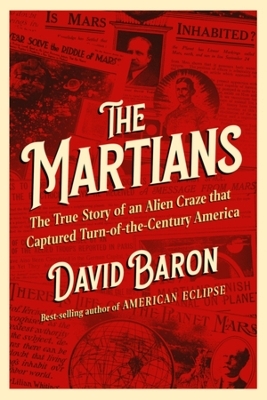
The Martians
The True Story of an Alien Craze that Captured Turn-of-the-Century America
Seiten
2025
WW Norton & Co (Verlag)
978-1-324-09066-3 (ISBN)
WW Norton & Co (Verlag)
978-1-324-09066-3 (ISBN)
- Noch nicht erschienen (ca. Oktober 2025)
- Versandkostenfrei innerhalb Deutschlands
- Auch auf Rechnung
- Verfügbarkeit in der Filiale vor Ort prüfen
- Artikel merken
“There Is Life on the Planet Mars” —New York Times, December 9, 1906
The Times headline was no joke. In the early 1900s, many Americans actually believed that we had discovered intelligent life on Mars. The Martians—a truly bizarre tale reconstructed through newly discovered clippings, letters, and photographs by bestselling science writer David Baron—begins in the 1890s with Percival Lowell, a wealthy Harvard scion who was so certain of his Mars discovery that he (almost) convinced a generation of astronomers that grainy telescopic photographs of the red planet revealed meltwater and an intricate canal system, declaring “there can be no doubt that living beings inhabit our neighboring world” (New York Times). So frenzied was the reaction that international controversies arose. Tesla announced he had received Martian radio signals. Biologists debated whether Martians were winged or gilled. Martians headlined Broadway shows, and a new genre called science fiction arose. While Lowell’s claims were savagely debunked, his influence sparked a compulsive interest in Mars and life in outer space that continues to this day.
The Times headline was no joke. In the early 1900s, many Americans actually believed that we had discovered intelligent life on Mars. The Martians—a truly bizarre tale reconstructed through newly discovered clippings, letters, and photographs by bestselling science writer David Baron—begins in the 1890s with Percival Lowell, a wealthy Harvard scion who was so certain of his Mars discovery that he (almost) convinced a generation of astronomers that grainy telescopic photographs of the red planet revealed meltwater and an intricate canal system, declaring “there can be no doubt that living beings inhabit our neighboring world” (New York Times). So frenzied was the reaction that international controversies arose. Tesla announced he had received Martian radio signals. Biologists debated whether Martians were winged or gilled. Martians headlined Broadway shows, and a new genre called science fiction arose. While Lowell’s claims were savagely debunked, his influence sparked a compulsive interest in Mars and life in outer space that continues to this day.
David Baron is an award-winning journalist, broadcaster, and author of The Beast in the Garden and American Eclipse. A former science correspondent for NPR, he has also written for the New York Times, Washington Post, Wall Street Journal, Los Angeles Times, Scientific American, and other publications. David recently served as the Baruch S. Blumberg NASA/Library of Congress Chair in Astrobiology, Exploration, and Scientific Innovation. He lives in Boulder, Colorado.
| Erscheint lt. Verlag | 10.10.2025 |
|---|---|
| Zusatzinfo | 101 illustrations |
| Verlagsort | New York |
| Sprache | englisch |
| Maße | 152 x 229 mm |
| Themenwelt | Geisteswissenschaften ► Geschichte ► Regional- / Ländergeschichte |
| Naturwissenschaften ► Physik / Astronomie ► Astronomie / Astrophysik | |
| Sozialwissenschaften ► Ethnologie | |
| Sozialwissenschaften ► Soziologie | |
| Technik ► Luft- / Raumfahrttechnik | |
| ISBN-10 | 1-324-09066-9 / 1324090669 |
| ISBN-13 | 978-1-324-09066-3 / 9781324090663 |
| Zustand | Neuware |
| Haben Sie eine Frage zum Produkt? |
Mehr entdecken
aus dem Bereich
aus dem Bereich
Universalgelehrter, Polarreisender, Entdecker
Buch | Hardcover (2024)
mareverlag
28,00 €


